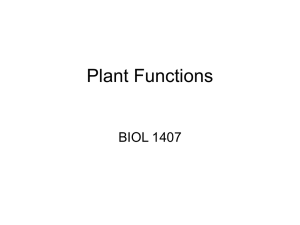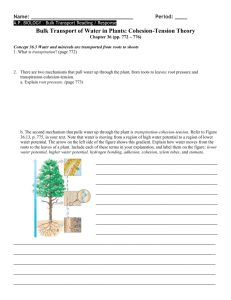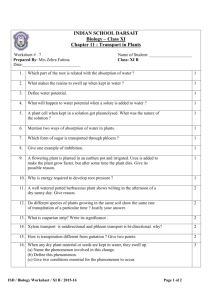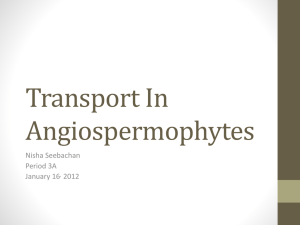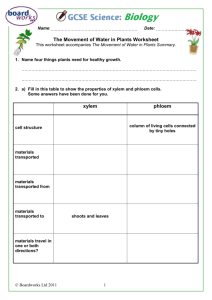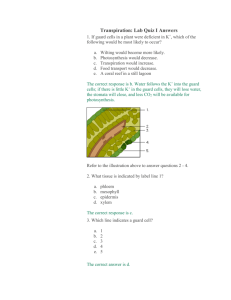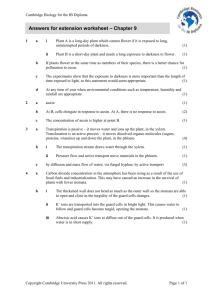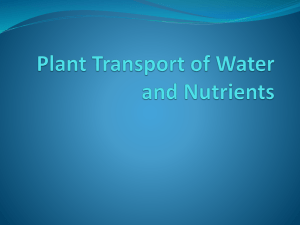Plant Transport Worksheet: Transpiration, Xylem, Phloem
advertisement
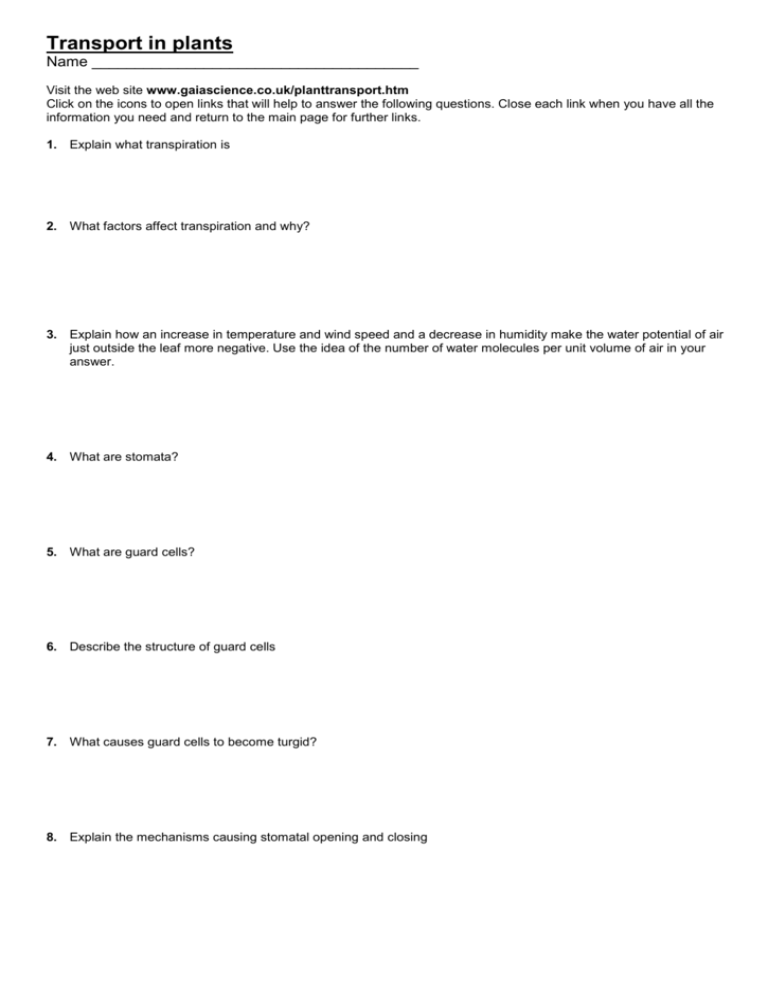
Transport in plants Name ______________________________________ Visit the web site www.gaiascience.co.uk/planttransport.htm Click on the icons to open links that will help to answer the following questions. Close each link when you have all the information you need and return to the main page for further links. 1. Explain what transpiration is 2. What factors affect transpiration and why? 3. Explain how an increase in temperature and wind speed and a decrease in humidity make the water potential of air just outside the leaf more negative. Use the idea of the number of water molecules per unit volume of air in your answer. 4. What are stomata? 5. What are guard cells? 6. Describe the structure of guard cells 7. What causes guard cells to become turgid? 8. Explain the mechanisms causing stomatal opening and closing 9. Use your knowledge of leaf structure to explain why less water is lost through the upper surface of leaves than is lost through the lower surface. 10. Some plants that are adapted to living in hot environments can close their stomata during the middle of the day when the temperature is highest and can open them at night. The effect of this lunchtime stomatal closing is that transpiration almost ceases. What are the advantages and disadvantages to a desert plant opening its stomata during the night and closing them around midday? 11. What is a xerophyte? 12. The following are adaptations in xerophytes that reduce water loss. Explain how these adaptations enable xerophytes to survive in deserts a. Spines not just to deter animals from eating them to get at stored water b. Epidermis has thick waxy cuticle c. Succulent stems d. Hydrotropic root system e. Low stomata density f. Sunken stomata g. Rolled leaves (some xerophytes eg Marram grass) 13. The epidermal cells of cacti have chloroplasts so they can photosynthesise. Why is this important? 14. Some desert plants lose their root hairs during the long, dry season. After rainfall, new root hairs grow within hours. Explain the advantage of having no root hairs during the dry season. 15. Why does the cactus stem have stomata? 16. These stomata are closed during the day. How does the cactus obtain CO 2 needed for photosynthesis? 17. Although Cacti seem well adapted for life in deserts their growth rate is usually very slow. Suggest a reason for this. 18. Draw a diagram of a cross section of Marram grass. 19. What causes the Marram grass leaves to roll into a tight cylinder? 20. What 2 adaptations reduce the rate of transpiration in the Maram grass even when it is uncurled? a. b. 21. Draw a diagram of a cross section of a young root. Identify the following structures and explain their importance: a. Epidermis b. Cortex c. Casparian strip d. Central core 22. Explain what is meant by the movement of water along the symplast pathway 23. Explain what is meant by the movement of water along the apoplast pathway 24. Explain what is meant by the movement of water along the vacuolar pathway 25. All water passes through the endodermis by the same pathway. Explain what causes this. 26. What are plasmodesmata? 27. Describe the formation of Xylem 28. How is xylem tissue adapted for its function? 29. A stem was cut from a transpiring plant. The cut end of the stem was put into a solution of picric acid, which kills plant cells. The transpiration stream continued. Suggest an explanation for this observation. 30. What are tracheids? 31. What is the driving force for pulling the water up through the xylem vessels? 32. What is the material called that impregnates mature xylem cells strengthening the tubes? 33. Describe in detail what is meant by the cohesion – tension mechanism that moves water through xylem 34. What source of energy is used to pull water up a plant? 35. What is suberin? 36. What is the purpose of the Casparian strip? 37. What is meant by root pressure? 38. Describe the distribution of xylem and phloem in stems, roots and leaves. Stems Roots Leaves 39. Explain why the xylem and phloem are distributed differently in stems roots and leaves. Stems Roots Leaves 40. How would experiments with respiration inhibitors provide evidence for the active transport of ions in the root hairs? 41. Uptake of ions in root hairs is elective. Why is this an advantage? 42. What is translocation? 43. Describe, with the aid of a diagram, the structure of phloem 44. Why are companion cells important? 45. Describe and explain two ways in which the sieve tubes are adapted for their transport function. a. b. 46. Describe and explain how you would expect the sugar content in the phloem of a plant to vary over a period of 24 hours. 47. The Mass flow hypothesis best explains phloem transport. What is the mass flow hypothesis? 48. Ringing experiments are used to show the route taken by mineral ions. Explain how ringing experiments are carried out and what they show. 49. Explain the terms ‘source’ and ‘sink’ in connection with translocation. 50. The mass flow hypothesis depends on there being a difference in pressure in the phloem sieve tubes between the source and the sink. Explain how sugars cause the pressure to increase at the source end according to the mass flow hypothesis.
